
This Article From Issue
January-February 2021
Volume 109, Number 1
Page 4
DOI: 10.1511/2021.109.1.4
To the Editors:
I am writing to raise concerns about the editors’ decision not to use the collective portrait of women scientists from my article, The Women Who Discovered RNA Splicing for the cover of the September–October 2020 issue.
This collective portrait is a powerful visual that captures key aspects of my article. It conveys the women’s substantial presence (half a dozen) in a major scientific discovery. Most readers, who may have never encountered so many women scientist coauthors in a major discovery, would have been curious to learn more about their contributions, especially since the Nobel Prize for this discovery was given to two men.
The portrait also counteracts ethnic bias in general and its intersectionality with gender bias in particular. Of the women scientists involved in the discovery of RNA splicing, four came from Asia (China, India, and Israel) and two from the United States. This cultural and regional diversity resonates well with the readers’ increasing interest in ethnic diversity while also providing young girls with much needed, multinational role models.

Stephanie Freese
The article’s key message on the corrosive impact of gender bias and injustice on the integrity of science would have been more memorable if transmitted by a cover projecting the diverse faces of the article’s protagonists—women scientists personifying a long-lasting injustice.
I recognize that there are various constraints—technical, artistic, commercial, and others—that prevail in the process of determining the cover choice. In the aftermath of a prolonged public debate on the persistent underrepresentation of women in science, however, none of these plausible constraints justify displacing the evocative portrait of several women scientists whose story reveals key issues about bias, justice, and integrity in scientific discovery.
A tradition of avoiding any portraits on the cover was mentioned as a reason for this decision. But such a tradition reflects a double standard: Men don’t need to be on the cover to signal their role in major discoveries, because such a role is culturally assumed and touted even when, as my article suggests, their sole role was anything but self-evident. By contrast, persisting gender bias has long prevented women from being recognized for their key roles in various discoveries, including the one discussed in my article. How can these women scientists be rescued from oblivion as a new type of discoverer if they are banned or invisibilized from the cover? If American Scientist wants to signal that “Women’s Discoveries Matter!,” then their portraits should appear on the cover.
Pnina G. Abir-Am
Belmont, MA
Editors’ note: It is unusual for American Scientist to publish letters from authors about their own articles, but we wished to publicly acknowledge Dr. Abir-Am’s views. The editors of American Scientist feel that the subject of Dr. Abir-Am’s article is of great importance, which was why we worked extensively with her to produce it for the magazine and commissioned the above portrait to go with it. American Scientist has a long history of tackling intersectional issues of gender and inclusion in science. American Scientist does not repeat internal artwork on covers. In addition, the magazine has a long-standing policy of not using images of any actual people on covers, to keep the focus on concepts and to avoid portraying science as anything other than a collective endeavor built by many people. The choice of cover does not indicate any judgment on the worth of an article. The many forces of bias at play in the misallocation of this scientific credit were difficult to conceptually represent on the cover, but that makes them no less important among the topics we covered in this issue. Acknowledging underrepresented groups in science and increasing their representation are very important to American Scientist, and we continue to look for creative, evocative ways to do so. Dr. Abir-Am’s article has been featured in our electronic newsletter and on our social media feeds, receiving a highly positive response from readers.
To the Editors:
I rarely read an entire issue of American Scientist, but I was attracted by the photograph of a dingo on the September–October 2020 cover and started reading about The Elusive Dingo. Then I went forward to Empowering Success (Science Policy), Robogamis Are the Real Heirs of Terminators and Transformers (Technologue), What Happened to the Genoa Bridge? (Engineering), Why Did Chinese Farmers Switch to Wheat? (Perspective), A More Universal Language (Sightings), Natural History Collections Hold a Hidden Trove of Disease Data (Spotlight), Developing New Vaccines (First Person), and In Bulgaria, a Cave of Many Questions (Spotlight). Fascinated by what I learned in those articles, I worked the other way from the dingo article to find the socially important The Women Who Discovered RNA Splicing, the humorous Stop Me If You’ve Heard This Theorem Before, and the extensive book reviews in Scientists’ Nightstand. Kudos to those who planned and executed this issue with its broad range of hard-science, soft-science, and history- of-science articles.
Douglas Daetz
Sunnyvale, CA

American Scientist Comments and Discussion
To discuss our articles or comment on them, please share them and tag American Scientist on social media platforms. Here are links to our profiles on Twitter, Facebook, and LinkedIn.
If we re-share your post, we will moderate comments/discussion following our comments policy.